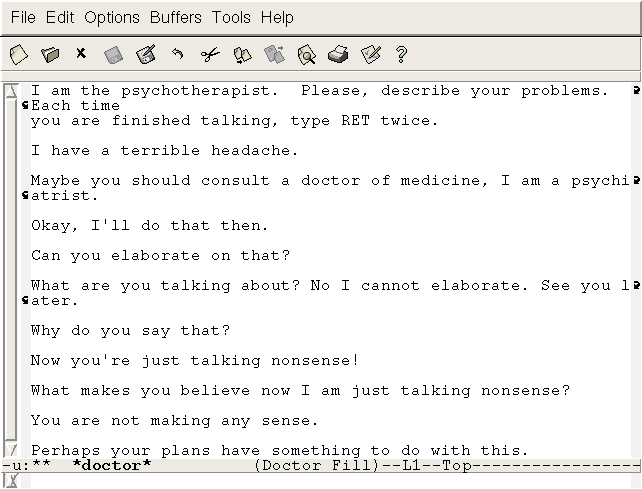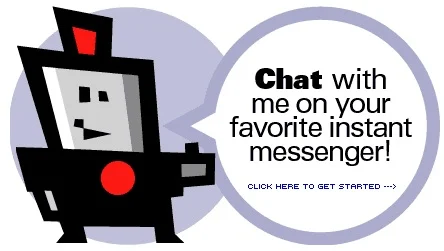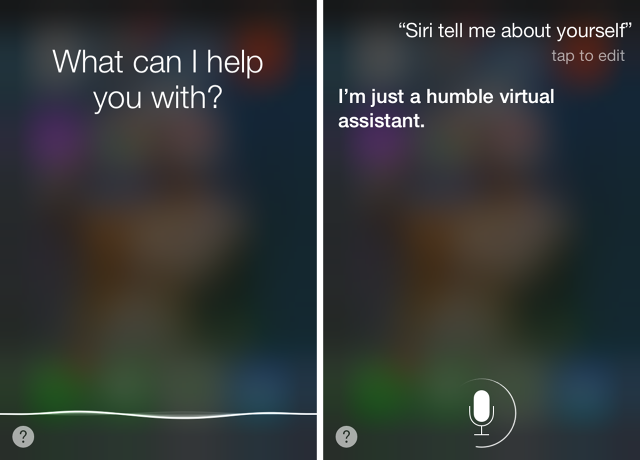The critically unloved 1999 film Bicentennial Man seems like an odd turning point in the evolution of chatbots, but for Robert Hoffer, Robin Williams’s performance as an intelligent robot was an inspiration.
“I wanted to build that, you know?” says Hoffer, a co-creator of the SmarterChild chatbot that lived atop early messaging programs such as AOL Instant Messenger and MSN Messenger. “I wanted to have an intelligence you could talk to on the Internet that would become your best friend for life.”
Beyond just holding a conversation, SmarterChild wanted to be useful, tapping into web services to provide sports scores, weather forecasts, stocks, and other info. Those ambitions make it an obvious precursor to today’s resurgence of chatbots, led by booming startups such as Slack and Kik, and attracting tech giants such as Facebook and Microsoft.
Still, the bots you’re seeing today don’t much resemble SmarterChild and its predecessors—or Bicentennial Man, for that matter. The news, weather, shopping, and customer service chatbots on Facebook Messenger don’t want to be your friend. The bots that help teams run more efficiently in Slack aren’t trying to pass as human. There are exceptions–bots built with ToyTalk’s PullString.ai platform, for instance, put an emphasis on personality–but in most cases, the relationship is transactional, and pleasantries are an afterthought.
It may seem paradoxical, but this shift away from humanity might be what finally allows chatbots to succeed.
The ELIZA Problem
In 1966, long before Hoffer and his colleagues created SmarterChild, an MIT computer scientist named Joseph Weizenbaum published ELIZA, a program for mimicking human conversation. ELIZA worked by parsing the words that users entered into a computer, and then matching them to a list of possible scripted responses.
ELIZA, using a script that simulated a psychotherapist, proved to be a major influence on natural language processing and artificial intelligence, with copies and variants popping up at universities around the country. But Weizenbaum was troubled by the reaction. He intended ELIZA to be a mere parody of human conversation, yet suddenly users were confiding their deepest thoughts in ELIZA, and experts were declaring that chatbots would be indistinguishable from humans within a small number of years.

In his book Computer Power and Human Reason, Weizenbaum rejected the notion that machines could replace human intellect. He argued instead that such machines were just tools, and extensions of the human mind. He further stressed that machines’ understanding of language was entirely dependent on the context in which they were used, and argued that a more general computer understanding of human language was not possible.
Yet in the decades that followed, chatbot makers have built upon Weizenbaum’s model to strive for more human-like interactions. Passing the Turing test has become a common goal, with contests such as the Loebner Prize set up to test new bots’ conversational skills against a panel of human judges. So far, though, Weizenbaum has been right about machines’ limitations: Despite significant advancements (and some exaggerated claims from bot makers), no one has been able to pass a true Turing test.
“The hardest thing in the Turing test issue is that there’s no limit on what people can talk about,” says Michael “Fuzzy” Mauldin, the founder of Lycos and the creator of Verbots, a popular chatbot development tool from the 1990s. “And even if you tell people to restrict their conversations to a single topic, they bring in their entire world experience.”
Even recent advances in big data and artificial intelligence haven’t solved the problem. Using large amounts of training data and processing power, it’s now possible to teach a machine to understand and speak to humans. But as Mauldin notes, this can create new headaches when the training data spins out of control. (See: The racist and sexist outbursts of Microsoft’s Tay chatbot.)
“If you look at what you’ve built, it’s this massive pile of numbers,” Mauldin says. “There’s no way to look at it and make sure the solution is correct, or is what you want, because it’s all gray goo inside, just like a real brain.”
Enter SmarterChild
Although chatbots proliferated among academics, programmers, and enthusiasts for years after ELIZA’s creation, SmarterChild was the first to become a widespread consumer phenomenon. Peter Levitan, who served as CEO of SmarterChild’s maker ActiveBuddy, has said that the chatbot attracted over 30 million users, and at one point accounted for 5% of global instant messenger traffic.
SmarterChild was able to reach so many people because it was built upon the world’s dominant messaging platforms–just as new chatbots are designed to run on Facebook Messenger–and because it was as fast and easy as talking with a friend. But what really made this chatbot unique was how it straddled the line between human-like interaction and machine-like utility.

If you wanted, you could have a pleasant conversation with SmarterChild, which relied on the same concept of pattern matching and scripted answers that ELIZA used decades earlier. Alternatively, you could curse at it, or make advances toward it, and it would always seem to know how to respond. (SmarterChild’s creators don’t shy from the notion that trying to trick the bot was a popular pastime. “I believe that trying to convince SmarterChild to have sex with you was the first Internet meme,” Hoffer says.)
When you tired of idle chitchat or mockery, SmarterChild could instead provide useful information. To make this happen, ActiveBuddy partnered with various service providers to offer weather, stocks, movie listings, and more. This was all part of the business plan to provide an intelligent assistant.
“Once you have a relationship with someone, that relationship expands in different ways,” says Andy Weissman, one of ActiveBuddy’s first investors. “And so once you have a personal relationship with SmarterChild . . . then you’ll do your web searches through there, then you’ll get your baseball scores. It’s an easier way to introduce all these other services, and you always can fall back on how it feels like a relationship with this robot.”
But in the early 2000s, building this kind of master intelligence was difficult work. As Hoffer notes, every branch of a conversation had to be scripted, and ActiveBuddy was constantly adding to the script in response to what the company learned from users.
“All of that interaction was editorialized and programmed, and therefore required an enormous staff as it grew,” Hoffer says.
SmarterChild faced obstacles on the business side as well. Every source of information required a partnership with specific companies, as this was before the age of open web service APIs that any developer could tap into. And because SmarterChild was so popular, it was constantly running into limits on its host messaging platforms.
“We had these enormous, bureaucratic, profit-driven, ad-driven media firms–Yahoo, AOL, Microsoft–and we had to negotiate carriage with each company. And that was hell,” Hoffer says.
After a couple years, ActiveBuddy pivoted to providing virtual customer service agents for businesses. While the move was successful from a business standpoint–it culminated in a 2006 acquisition by Microsoft–Weissman has some regrets about not sticking with SmarterChild as the core business.
“It captured something with users,” Weissman says. “We don’t know, because we didn’t play it out, what it really captured, but you don’t see that that often, and we could have tried to ride that all the way to the end to see what it was.”
Utility Prevails
After SmarterChild, chatbots spent several years in the wilderness. Microsoft shut down the division where SmarterChild’s tech resided, and consumer-facing tech companies in general avoided the concept.
But over the past few years, chatbots have made a comeback. With advancements in processing power, bots now have a better ability to interpret natural language and learn from users over time. Just as importantly, big companies like Facebook, Apple, and Microsoft are now eager to host our interactions with various services, and offer tools for developers to make those services available. Chatbots easily fit into their larger business models of advertising, e-commerce, online services, and device sales. Meanwhile, services that want to reach hundreds of millions of customers on a platform like Messenger will be helping to write the chat scripts.
“A lot of the things that were barriers to us back then are no longer barriers to us today because of the evolution of the way technology works,” Hoffer says.
Crucially, these bots are meant to be useful out of the gate, so unlike SmarterChild, they no longer need conversation as a crutch for mass adoption. Sure, Apple’s Siri knows how to break the ice with a few jokes, but it largely exists to help you get things done. Rival assistants from Google and Amazon don’t exhibit much personality at all. Utility is winning out because the technology allows for it.

And with the chatbots built into messaging apps like Facebook Messenger and WeChat, the interaction is only vaguely conversational. When you use the 1-800-Flowers chatbot, for instance, you’re given a set of pre-written responses that help guide you to the appropriate bouquet. It’s not just the machine side of the interaction that’s scripted anymore.
If the latest round of chatbots succeed, they might prove that Weizenbaum, the creator of ELIZA, was right all along. These machines are not warm and cuddly replacements for the human intellect. They’re just another set of tools–an evolution of the apps that have served us for years.
In other words, we wouldn’t just be playing with chatbots anymore. We’d be using them.
Recognize your brand’s excellence by applying to this year’s Brands That Matter Awards before the early-rate deadline, May 3.
